Attached files
| file | filename |
|---|---|
| 8-K - FORM 8-K - MOLINA HEALTHCARE, INC. | a58451e8vk.htm |
| EX-99.1 - EX-99.1 - MOLINA HEALTHCARE, INC. | a58451exv99w1.htm |
Exhibit 99.2

| New York, New York January 26, 2011 INVESTOR DAY 2011A |

| Cautionary statement "Safe Harbor" Statement under the Private Securities Litigation Reform Act of 1995: This slide presentation, as well as our accompanying oral remarks, contain numerous "forward- looking statements" regarding our operations for 2011 and subsequent fiscal years. All of our forward-looking statements are subject to numerous risks, uncertainties, and other factors that could cause our actual results to differ materially. Anyone viewing or listening to this presentation is urged to read the risk factors and cautionary statements found under Item 1A in our 2009 Annual Report on Form 10-K filed on March 16, 2010, our first, second and third quarter 2010 Quarterly Reports filed on May 10, 2010, August 4 2010, and November 4, 2010, respectively, and the risk factors and cautionary statements found in our other reports and filings with the Securities and Exchange Commission and available for viewing on its website at www.sec.gov. Except to the extent otherwise required by federal securities laws, we do not undertake to address or update forward-looking statements in future filings or communications regarding our business or operating results. 2 |

| Agenda Agenda 3 |

| Fee-based fiscal agent services, business process outsourcing, and care and utilization management Non-risk, fee business with higher margins and no regulatory capital requirement Who we are 4 No other company in the Medicaid space can do all three Health Plans Medicaid Health Information Mgmt Healthcare Direct Delivery We are a multi-state health care organization with flexible care delivery systems focused exclusively on government-sponsored health care programs for low income families and individuals Company owned or company operated primary care community clinics Provide high quality patient care in selected geographies Risk-based health plan outsourcing for Medicaid and other government programs (includes risk medical management) 4 |

| New York, New York January 26, 2011 New York, New York January 26, 2011 Business Overview J. Mario Molina, MD President & Chief Executive Officer |

| Business snapshot Markets and members served - Q3 2010 Washington 353,000 California 349,000 New Mexico 91,000 Utah 78,000 Texas 96,000 Missouri 79,000 Michigan 225,000 Ohio 241,000 Florida3 57,000 Health plan enrollment growth Health plan membership profile (in thousands) (in thousands) Molina Healthcare Health Plans Molina Medicaid Solutions Idaho Maine Louisiana West Virginia New Jersey Virginia clinics provide Direct Delivery. Molina acquired the Wisconsin health plan on September 1, 2010. As of September 30, 2010, the Wisconsin health plan had approximately 3,000 Medicare Advantage members covered under a reinsurance contract with a third party; these members are not included in the membership count shown above. Florida has a managed care program as well as a Pharmacy Rebate Program. Virginia1 Wisconsin2 28,000 (CHART) AGED, BLIN D & DISABLED MEDICARE 1% 82% TANF 8% CHIP 9% 6 |
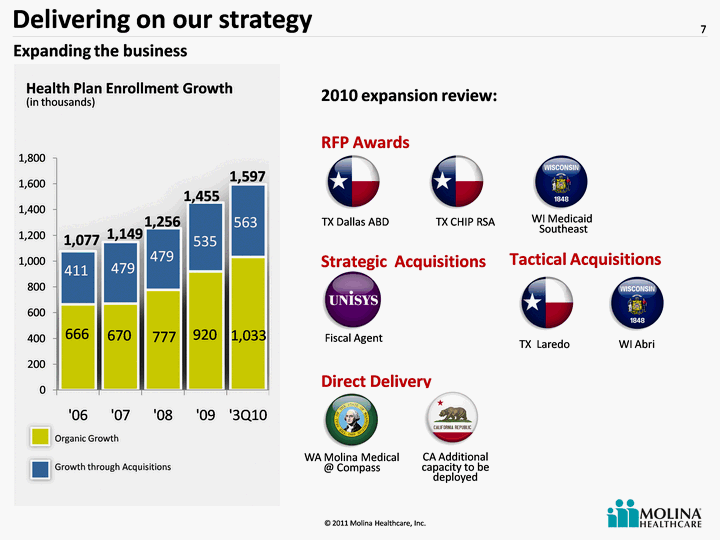
| Expanding the business RFP Awards Tactical Acquisitions Direct Delivery TX Dallas ABD TX CHIP RSA WI Medicaid Southeast TX Laredo WI Abri WA Molina Medical @ Compass Delivering on our strategy CA Additional capacity to be deployed 2010 expansion review: Strategic Acquisitions Fiscal Agent Organic Growth 666 670 777 920 1,033 411 479 479 535 563 1,077 1,149 1,256 1,455 1,597 Growth through Acquisitions Health Plan Enrollment Growth (in thousands) 7 |

| Accelerating growth in health plan opportunities In the next three years, it is expected that states will be offering many new Medicaid RFPs or expansions in order to avoid disruption in 2014. GA FL IL TX AZ TANF Lives .9M 1.3M 1.8M 1.8M - ABD Lives .4M .3M - .4M .027M CHIP Lives .2M - - .3M - Total Lives 1.5M 1.6M 1.8M 3.2M .027M RFP 2/11 n/a n/a 2/11 1/11 Go Live 7/12 n/a n/a 3/12 10/11 Total Revenue Opportunity $5.0B $4.3B $3.6B $9.9B $1.1B Examples of expected Health Plan RFPs include: 1 Re-procurement of ALTCS program (Acute + Long Term Care Services for Medicaid Enrollees) Based on current PMPM rates State evaluating RFP 2 3 3 8 |

| Organizing for health care reform 59M 2014-2018 2010 2019 16M 75M Medicaid Expansion 1 Sources: 1. CMS, Congressional Budget Office; does not include organic population growth. 2010. Unit designed to focus leadership attention on the key aspects of reform, while allowing leaders to continue to run the business. Reviews critical health care reform information and analysis Addresses enterprise strategic inquiries regarding reform Provides direction and allocates resources to enable reform readiness Leverages internal expertise Disseminates important information to key employees and constituents In preparation for the large scale change associated with health care reform, Molina has organized a dedicated unit to address health care reform strategy, policy and information, reform readiness and implementation. Estimated Enrollment Growth (2010-2019) Areas of Uncertainty : Exchanges Redetermination of eligibility Provider payments (Medicaid @ Medicare Rates) Federalization of Medicaid Uniformity/Regionalization of MMS Patient ratios Coordination with other government programs 9 |
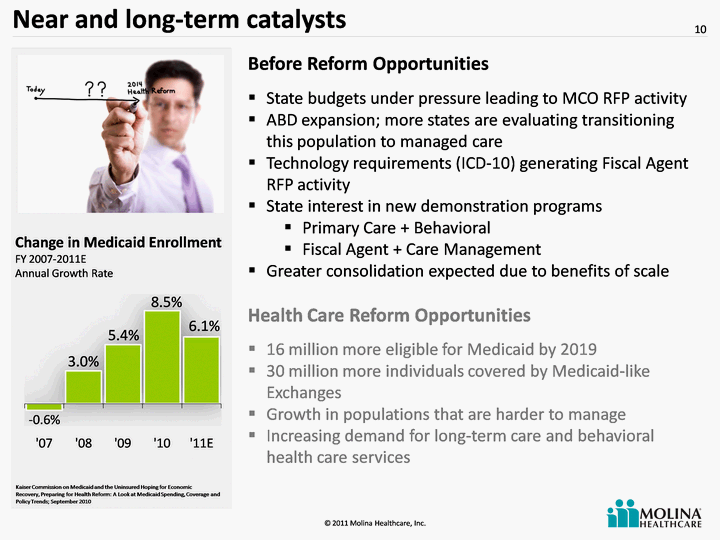
| Near and long-term catalysts Before Reform Opportunities State budgets under pressure leading to MCO RFP activity ABD expansion; more states are evaluating transitioning this population to managed care Technology requirements (ICD-10) generating Fiscal Agent RFP activity State interest in new demonstration programs Primary Care + Behavioral Fiscal Agent + Care Management Greater consolidation expected due to benefits of scale Health Care Reform Opportunities 16 million more eligible for Medicaid by 2019 30 million more individuals covered by Medicaid-like Exchanges Growth in populations that are harder to manage Increasing demand for long-term care and behavioral health care services Change in Medicaid Enrollment FY 2007-2011E Annual Growth Rate Kaiser Commission on Medicaid and the Uninsured Hoping for Economic Recovery, Preparing for Health Reform: A Look at Medicaid Spending, Coverage and Policy Trends; September 2010 10 |

| Benefits of scale Over the next three years, health insurance plans are required to upgrade their systems for diagnosis, procedure coding and claims processing to the International Classification of Diseases - ICD-10. Per-Member Estimated Cost of ICD-10 Implementation by size of company Source: America's Health Insurance Plans, Center for Policy and Research. September 2010 Department of Health and Human Services will require U.S. payers and providers to fully transition to ICD-10 by 10/2013 ICD-10 implementation will result in incremental information technology spend Capital requirements will significantly burden small health plans with limited access to capital ICD-10 represents a revenue opportunity for Fiscal Agent business partially mitigating costs on the MCO side May result in greater consolidation as smaller plans cannot absorb costs 11 |

| Why managed care is a viable solution Although some States project improved cash flows over the next few years as the economy recovers, States' fiscal conditions remain very weak. (CHART) -$110 -$191 -$160 -$140 State Budget Shortfalls After Use of Recovery Act Funds Budget shortfalls in billions Source: Center on Budget and Policy Priorities. Analysis using data from U.S. Department of Health and Human Services, U.S. Department of Education, Congressional Budget Office, and state budget documents. December 2010 Budget gaps offset by Recovery Act and extension Remaining Budget gaps after Recovery Act and extension States will look for Medicaid health plans to provide budget certainty, cost savings, and flexible financing mechanisms. Utah: Transition from cost plus contract to full risk in late 2009 Ohio: Switched from pre-payment of its premium, to mid-month payments in which premium is earned California: Delayed premium payments or issued State IOUs until budget was finalized (100 days late) 12 |

| Molina Direct Delivery The growing and aging U.S. population foreshadows an increasing shortage of physicians over the next 15 years. Health care reform is estimated to worsen the shortfall by 25%. The shortfall will be most acutely felt among already underserved populations. Approximately 20% of California health plan membership now being served by plan's primary care clinics Increasing capacity to accommodate ABD growth in California and Washington Increased access to primary care through collocation with behavioral health provider Expansion in direct delivery provides a vehicle for capturing increases in reimbursement 170 160 150 140 130 120 110 100 2000 2015 2020 2025 Index of growth in number of physicians Index of growth in total U.S. population Index of growth in total U.S. population, age 65+ Sources: Associate of American Medical Colleges, "The Physician Shortage and Health Care Reform" https://www.aamc.org/download/70308/data/physicianshortagefs.pdf Percent Change (100 is baseline) Our clinics allow us to respond to the physician shortage. 13 |

| Quality and value 14 |

| Refocusing of Medicare Duals account for approximately 15% of Medicaid enrollees but contribute to 39% of all Medicaid spending Medicaid/Medicare spending averages $20K per dual per year, 5X greater than other Medicare beneficiaries Dual population will highly benefit from managed care Source: Kaiser Commission on Medicaid and the Uninsured, "Dual Eligbles" fact sheet, December 2010. http://www.kff.org/medicaid/upload/4091-07.pdf (CHART) Nearly 9 million Medicaid beneficiaries are dual eligibles: low-income seniors and younger persons with disabilities who are enrolled in both the Medicare and Medicaid programs. Change in Medicare Enrollment 2006-YTD 3Q2010 15 |
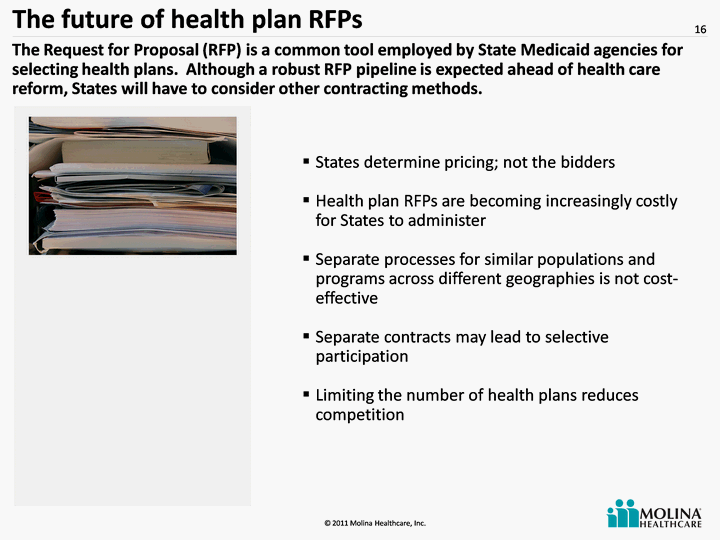
| The future of health plan RFPs The Request for Proposal (RFP) is a common tool employed by State Medicaid agencies for selecting health plans. Although a robust RFP pipeline is expected ahead of health care reform, States will have to consider other contracting methods. States determine pricing; not the bidders Health plan RFPs are becoming increasingly costly for States to administer Separate processes for similar populations and programs across different geographies is not cost- effective Separate contracts may lead to selective participation Limiting the number of health plans reduces competition 16 |

| Response to changes in FMAP Total & State Funds Medicaid Annual Spending Growth 2006-2010 (CHART) SOURCE: FY 2011 estimated by HMA. 2009 and 2010 from: Vernon Smith, Kathy Gifford, Eileen Ellis, Robin Rudowitz. Caryn Marks and Molly O'Malley, "The Crunch Continues: Medicaid Spending, Coverage and Policy in the Midst of a Recession," The Kaiser Commission on Medicaid and the Uninsured, September 2009. http://www.kff.org/medicaid/7985.cfm ARRA Enhanced FMAP (2009-2010) State General Fund Total Enhanced FMAP funding to states was extended for 6 months and is set to expire on June 30, 2011 if Congress does not act to extend it. An end to ARRA FMAP in July is estimated to increase States' non-federal share of Medicaid expenditures by over 30%. Possible state responses include changes in: Eligibility Provider Rates Benefits Utilization Controls Cost Sharing Use of managed care (expansion) 17 |

| Investment highlights Attractive sector growth prospects driven by government policies and economic conditions Proven flexible health care services portfolio (risk-based, fee-based and direct delivery) Diversified geographic exposure with significant presence in high growth regions Focus on government sponsored health care programs Seasoned management team with strong track record of delivering earnings growth Over 30 years of experience 18 |

| Panel 1 Q&A 19 |

| New York, New York January 26, 2011 Health Plan Update Terry P. Bayer Chief Operating Officer |

| Washington health plan (CHART) (CHART) Molina Healthcare of Washington Historical and YTD Enrollment 2006-YTD 3Q2010 Molina Healthcare of Washington Historical and YTD Enrollment 2006-YTD 3Q2010 Utilization management efforts Second clinic launched Request for proposal postponed 21 Note: MCR for Q3 2010 is YTD. |
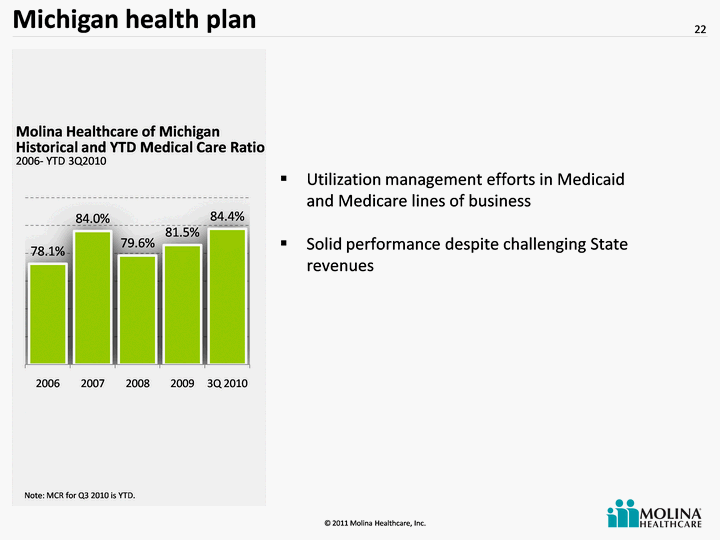
| Michigan health plan (CHART) Molina Healthcare of Michigan Historical and YTD Medical Care Ratio 2006- YTD 3Q2010 Utilization management efforts in Medicaid and Medicare lines of business Solid performance despite challenging State revenues 22 Note: MCR for Q3 2010 is YTD. |
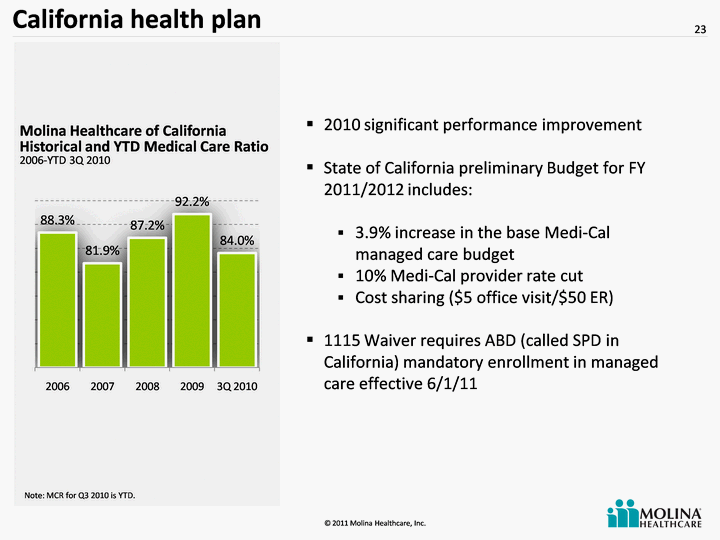
| California health plan 2010 significant performance improvement State of California preliminary Budget for FY 2011/2012 includes: 3.9% increase in the base Medi-Cal managed care budget 10% Medi-Cal provider rate cut Cost sharing ($5 office visit/$50 ER) 1115 Waiver requires ABD (called SPD in California) mandatory enrollment in managed care effective 6/1/11 Molina Healthcare of California Historical and YTD Medical Care Ratio 2006-YTD 3Q 2010 (CHART) 23 Note: MCR for Q3 2010 is YTD. |

| California 1115 Waiver expands ABD program Improved Care for vulnerable populations: enrollment of Seniors and Persons with Disability (SPD) in Medicaid managed care 380K new eligibles in California 260K new eligibles in Molina markets 12K additional enrolled with Molina by year end 2011 $10 billion Medicaid expansion plan to help California improve its health insurance program was approved. 24 |

| Ohio health plan Enrollment growing and medical costs managed 1/1/11 Rate Increase - of 4.5% ABD and CFC State managed care population expansions not anticipated before 2012 New Governor/Administration Molina Healthcare of Ohio Historical and YTD Medical Care Ratio and Enrollment 2006-YTD3Q 2010 25 Note: MCR for Q3 2010 is YTD. |

| Florida health plan Low enrollment (57K) Applying initiatives similar to California and Ohio Medical cost management initiatives Pharmacy Provider network re-contracting Behavioral health Molina Healthcare of Florida began its initial enrollment of Medicaid members in January of 2009 as part of a contract award by the Florida Agency for Health Care Administration (AHCA). (CHART) Ohio and Florida Medical Care Ratios by Quarter During First Two Years of Operations During the first several quarters after initial market entry, medical care ratios generally exhibit a high degree of fluctuation and remain elevated due to smaller populations and lack of provider familiarity with the heath plan. 26 |
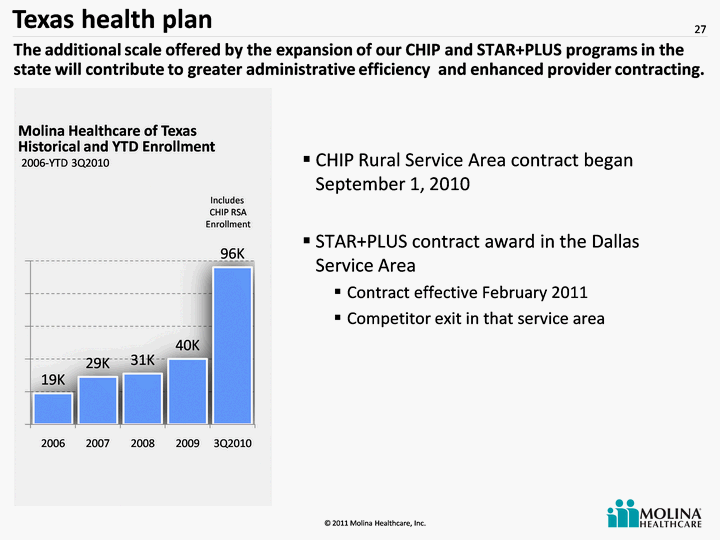
| Texas health plan CHIP Rural Service Area contract began September 1, 2010 STAR+PLUS contract award in the Dallas Service Area Contract effective February 2011 Competitor exit in that service area The additional scale offered by the expansion of our CHIP and STAR+PLUS programs in the state will contribute to greater administrative efficiency and enhanced provider contracting. (CHART) Molina Healthcare of Texas Historical and YTD Enrollment 2006-YTD 3Q2010 Includes CHIP RSA Enrollment 27 |
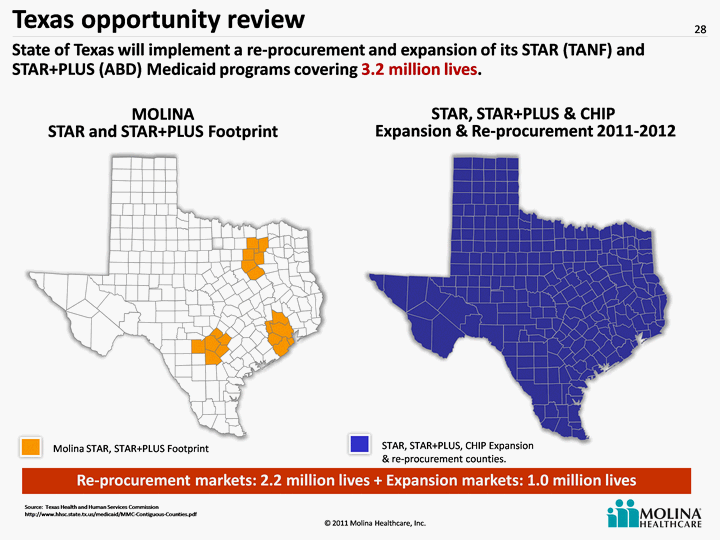
| Texas opportunity review MOLINA STAR and STAR+PLUS Footprint STAR, STAR+PLUS & CHIP Expansion & Re-procurement 2011-2012 Source: Texas Health and Human Services Commission http://www.hhsc.state.tx.us/medicaid/MMC-Contiguous-Counties.pdf State of Texas will implement a re-procurement and expansion of its STAR (TANF) and STAR+PLUS (ABD) Medicaid programs covering 3.2 million lives. Re-procurement markets: 2.2 million lives + Expansion markets: 1.0 million lives Molina STAR, STAR+PLUS Footprint 28 STAR, STAR+PLUS, CHIP Expansion & re-procurement counties. |

| Texas opportunity overview Through our current STAR, STAR+PLUS and CHIP RSA contracts, we have a strong network in place to build from to accommodate the STAR and STAR+PLUS expansion. Molina STAR, STAR+PLUS, and CHIP RSA Footprint Molina CHIP RSA Footprint Molina STAR, STAR+PLUS Footprint STAR, STAR+PLUS & CHIP Expansion & Re-procurement 2011-2012 STAR, STAR+PLUS, CHIP Expansion & re-procurement counties. 29 |

| California: Health plan owned & operated primary care clinics Citrus Heights, CA (1) Fontana, CA (1) Wilmington, CA (1) Lancaster, CA (1) Long Beach, CA (3) Moreno Valley, CA (1) Ontario, CA (1) Pomona, CA (2) Riverside, CA (1) San Bernardino, CA (1) Sacramento, CA (3) Virginia: 3 Company operated County-owned primary care health centers Fairfax County (3) Washington: mental health & primary care integration Everett, WA (2) Our approach to direct delivery is flexible and can accommodate changes in local market requirements and needs. We currently operate 21 clinics. Direct Delivery 30 |
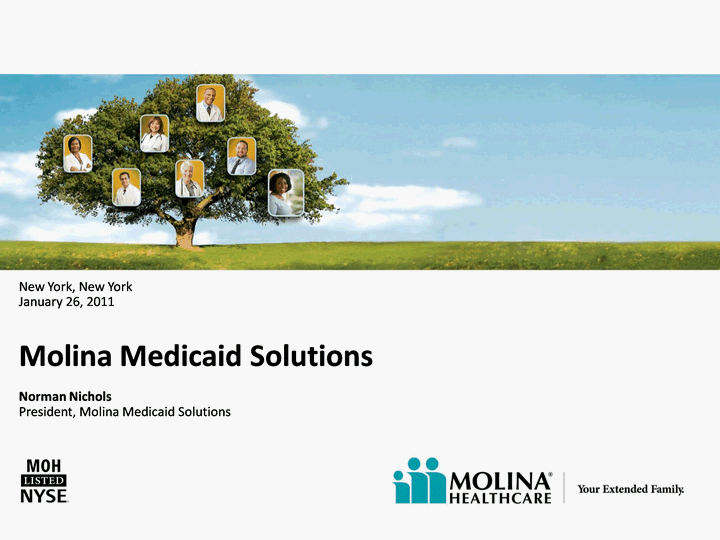
| New York, New York January 26, 2011 Molina Medicaid Solutions Norman Nichols President, Molina Medicaid Solutions |
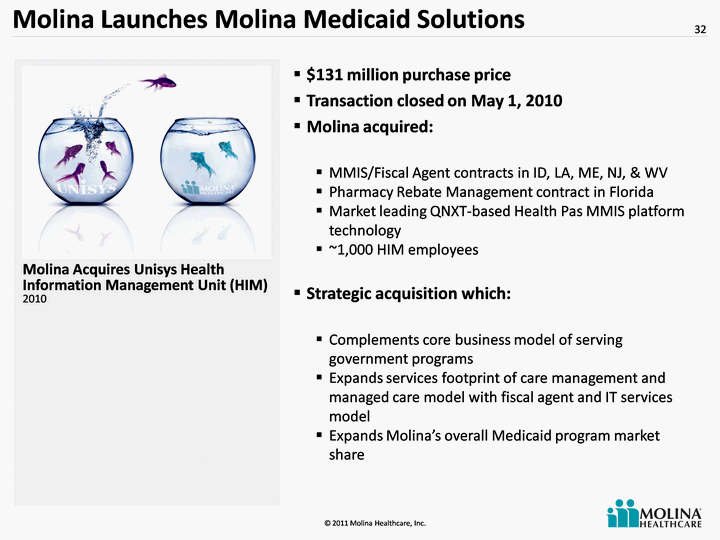
| Molina Launches Molina Medicaid Solutions $131 million purchase price Transaction closed on May 1, 2010 Molina acquired: MMIS/Fiscal Agent contracts in ID, LA, ME, NJ, & WV Pharmacy Rebate Management contract in Florida Market leading QNXT-based Health Pas MMIS platform technology ~1,000 HIM employees Strategic acquisition which: Complements core business model of serving government programs Expands services footprint of care management and managed care model with fiscal agent and IT services model Expands Molina's overall Medicaid program market share Molina Acquires Unisys Health Information Management Unit (HIM) 2010 32 |

| Medicaid systems & technology vendors Medicaid business processes are supported by vendors and systems, which provide Medicaid system, specialty or operational services. Managed Care Enrollment Brokers Third Party Liability Recovery Vendors Data Warehousing & Mgmt Solutions MMIS System Vendors (Fiscal Agent and BPO) ancillary and specialty vendors system of record Medicaid Agency (Outsourced Business Processes and Technology Solutions) 33 |

| MMS operational - First 6 Months Secured contract addendum to achieve 5010 compliance Secured three year extension through 3/2014 with 2 option years System went live on 9/2010 System went live on 6/2010 Supplemented with additional resources to support system implementation Enterprise Idaho Maine Louisiana West Virginia Deleveraged Molina Healthcare, Inc. through follow- on equity offering Integrated personnel (~1,000) Identified new leadership Re-branded 34 |

| MMIS market opportunity 35 MMIS has been around for more than 30 years and is one of the most expensive and complex system for states to maintain, enhance or replace. Outsourced to MMIS Vendors State Operated Other (i.e. Universities, vendor/state combinations) Notes: Expiration dates include optional extension years. Contracts currently held by Molina Medicaid Solutions. Source: Centers for Medicare and Medicaid Services. MMIS Fiscal Agent Contract Status Report May 21, 2010. $1.5 - 2BN spent annually with future spending focused on upgrading to 5010 and ICD-10 compliance/MITA compliance Fiscal Agent Contract Re-Competes 1 Year State 2011 Rhode Island Vermont Alabama Oklahoma Alaska West Virginia2 2012 New York Delaware Kentucky Nevada 2013 New Mexico Florida Kansas New Jersey2 2014 DC Virginia Indiana Montana Louisiana2 2015 Connecticut Pennsylvania Colorado Oregon Washington 2016 Iowa Wyoming Next 2 years $1.2B 35 |
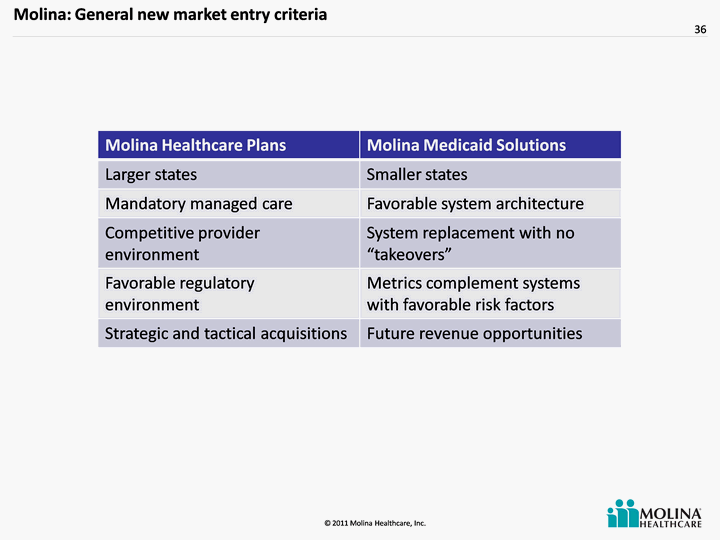
| Molina Healthcare Plans Molina Medicaid Solutions Larger states Smaller states Mandatory managed care Favorable system architecture Competitive provider environment System replacement with no "takeovers" Favorable regulatory environment Metrics complement systems with favorable risk factors Strategic and tactical acquisitions Future revenue opportunities Molina: General new market entry criteria 36 |

| Integration of COTS products Products can be stand-alone or used together as needed Products can be bolted on to existing legacy systems to enhance functionality MITA-aligned Unified database Immediate access to all data Eliminate non-integrated data storage stovepipes Configurable components Quick adaptability to policy changes with no programming Rules-based engine Written in understandable language User configurable settings Differentiation through strong systems solution Health Pas Definitions: COTS - Commercial-off-the-shelf MITA - Medicaid Information Technology Architecture 37 |

| Revenue opportunities 5010 Level 1 Compliance ICD 10 e-Prescribing integration with MMIS New Fraud and Abuse Reporting Requirements Health Information Exchange & Electronic Health Record Patient Protection and Affordable Care Act (PPACA) 2010 Medicaid regulatory requirements 38 |

| Revenue opportunities Care Management: Benefit Cost Containment: Care Coordination Welcome call to patient, health risk screening and identify desired outcome of patient iClinical Telephone Services for ER Intake notification for ER/UC for visits, admissions and interventions PAY4Performance Enhanced payment to medical community for improved metric outcomes - immunizations, HA1C or asthma protocols Length of Hospital Stays (LOS) deploying InterQual Assignment of LOS for hospital stays utilizing InterQual criteria by RNs MD-to-MD conferences for additional LOS consideration Rx Management Prior authorization and improved medication utilization by RNs and PDs Drug interchange, dosage selection and utilization reviews Quality based offering which improves patient compliance and clinical outcomes Offerings which enable Medicaid to lower benefit cost without impacting provision of quality care Fiscal agent and health plan synergies 39 |
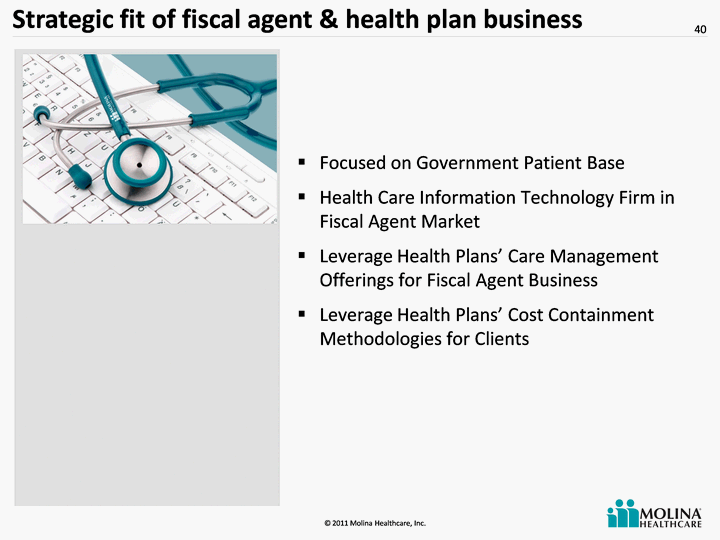
| Strategic fit of fiscal agent & health plan business Focused on Government Patient Base Health Care Information Technology Firm in Fiscal Agent Market Leverage Health Plans' Care Management Offerings for Fiscal Agent Business Leverage Health Plans' Cost Containment Methodologies for Clients 40 |

| Panel 2 Q&A 41 |

| New York, New York January 26, 2011 Minimum MCR Requirements Joseph White, CPA Chief Accounting Officer |

| Minimum MLR Requirements Requirement of Interim Financial Regulation (45 CFR Part 158): Individual and small group market minimum 80% MLR Large group market minimum 85% MLR Excludes Medicaid Companies Effective : January 1, 2011 Action: Rebates to all enrollees if MLR does not meet minimum requirement Implementation: Based on NAIC model regulation Calendar year reporting Three year average beginning with 2013 Credibility adjustment Reporting based on State-of-Issue States can require higher ratios 43 Section 2718 of the Public Health Services Act (as added by section 1001(5) of the Patient Protection and Affordable Care Act (ACA), is entitled, "Bringing Down the Cost of Health Care Coverage." |
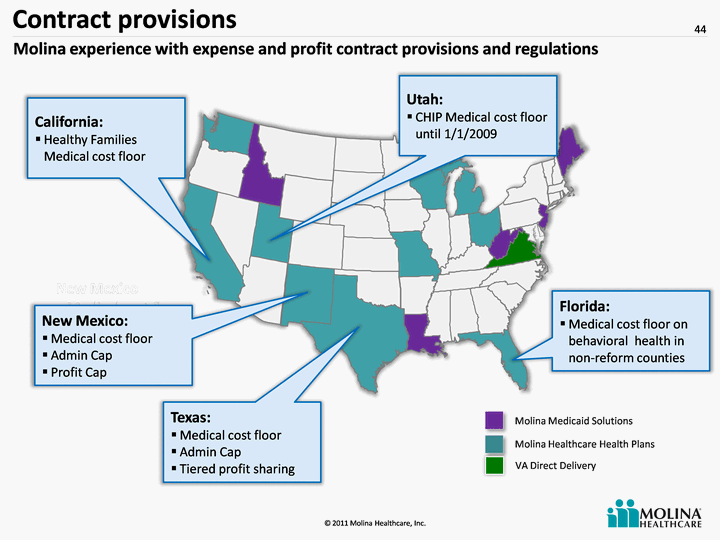
| Molina Healthcare Health Plans Molina Medicaid Solutions New Mexico Medical cost floor Admin Cap Profit Cap Utah CHIP Medical cost floor until 1/1/09 California: Healthy Families Medical cost floor New Mexico: Medical cost floor Admin Cap Profit Cap Texas: Medical cost floor Admin Cap Tiered profit sharing Florida: Medical cost floor on behavioral health in non-reform counties Utah: CHIP Medical cost floor until 1/1/2009 VA Direct Delivery 44 Molina experience with expense and profit contract provisions and regulations Contract provisions |

| How does ACA calculate an MLR? The Denominator Premiums Earned are increased by: Federal and State Taxes Premium taxes Regulatory authority licenses and fees Subsidies received from Federal and State high risk pools Revenue earned from the assumption of business from another entity Adjustments for experience rating refunds Premiums Earned are decreased by: Premiums refunded to members for wellness programs Assessments paid to Federal and State high risk pools 45 |

| How does ACA calculate an MLR? The Numerator: Paid Claims (adjusted for IBNP) are reduced by: RX rebates Claims-over payments recovered Paid Claims (adjusted for IBNP) are increased by: Cost of Fraud and Abuse prevention - to the extent it lowers medical costs Provider bonuses and incentives State stop-loss, market stabilization and claim/census based assessments Cost of activities that improve health care quality Cost of health information technology required to support quality efforts Paid Claims (adjusted for IBNP) must exclude: Amounts paid for secondary network savings Amounts paid for network development and administration Rebates paid to members under ACA 46 |

| Estimated Molina MLRs Based on ACA Standards Estimated Molina MLRs Based on ACA Standards 47 For the nine months end September 30, 2010 Estimated MLRs based on the Company's interpretation of ACA MLR regulations as of January 26, 2011, and subject to limitations in the Company's existing reporting systems and procedures with respect to MLR calculation methodologies. As of September 30, 2010 all Molina health plans had MLRs in excess of 85% based on the Company's interpretation of ACA standards. |

| New York, New York January 26, 2011 2011 & 2012 Outlook John C. Molina Chief Financial Officer |

| Cautionary Statement Safe Harbor Statement under the Private Securities Litigation Reform Act of 1995: This slide presentation contains numerous "forward-looking statements" regarding the Company's expected results for fiscal years 2011 and 2012. All of our forward-looking statements are based on our current expectations and assumptions, including, but not limited to, the assumptions stated in the slide presentation. Actual results could differ materially due to the unexpected failure of one or more of our assumptions, or due to adverse developments related to numerous risk factors, including but not limited to the following: significant budgetary pressures on state governments and their potential inability to fully fund Medicaid or CHIP in 2011 or 2012, to maintain the currently agreed-upon payment rates to our health plans, or to maintain existing benefit packages or membership eligibility thresholds or criteria; uncertainties regarding the impact of the Patient Protection and Affordable Care Act, including its possible repeal, judicial overturning of the individual insurance mandate, the effect of various implementing regulations, and uncertainties regarding the likely impact of other federal or state health care and insurance reform measures; management of our medical costs, including seasonal flu patterns and rates of utilization that are consistent with our expectations; the success of our efforts to retain existing government contracts and to obtain new government contracts in connection with upcoming state requests for proposals (RFPs) in both existing and new states, and our ability to grow our revenues consistent with our expectations; the accurate estimation of incurred but not reported medical costs across our health plans; risks associated with the continued growth in new Medicaid enrollees; retroactive adjustments to premium revenue or accounting estimates which require adjustment based upon subsequent developments, including Medicaid pharmaceutical rebates; the continuation and renewal of the government contracts of our health plans and of Molina Medicaid Solutions and the terms on which such contracts are renewed; the timing of receipt and recognition of revenue and the amortization of expense under the state contracts of Molina Medicaid Solutions; additional administrative costs and the potential payment of additional amounts to providers as a result of MMIS system issues in Idaho; government audits and reviews, including the audit of our Medicare plans by CMS; changes with respect to our provider contracts and the loss of providers; the establishment of a federal or state medical cost expenditure floor as a percentage of the premiums we receive, and the interpretation and implementation of medical cost expenditure floors, administrative cost and profit ceilings, and profit sharing arrangements; the interpretation and implementation of at-risk premium rules regarding the achievement of certain quality measures; approval by state regulators of dividends and distributions by our health plan subsidiaries; changes in funding under our contracts as a result of regulatory changes, programmatic adjustments, or other reforms; high dollar claims related to catastrophic illness; the favorable resolution of litigation or arbitration matters; restrictions and covenants in our credit facility; the relatively small number of states in which we operate health plans; the availability of financing to fund and capitalize our acquisitions and start-up activities and to meet our liquidity needs; a state's failure to renew its federal Medicaid waiver; an inadvertent unauthorized disclosure of protected health information; changes generally affecting the managed care or Medicaid management information systems industries; increases in government surcharges, taxes, and assessments; changes in general economic conditions, including unemployment rates; and numerous other risk factors, including those discussed in our periodic reports and filings with the Securities and Exchange Commission. These reports can be accessed under the investor relations tab of our Company website or on the SEC's website at www.sec.gov. Given these risks and uncertainties, we can give no assurances that our forward-looking statements will prove to be accurate, or that any other results or events projected or contemplated by our forward-looking statements will in fact occur, and we caution investors not to place undue reliance on these statements. All forward^looking statements in this slide presentation represent our judgment as of January 26, 2011, and we disclaim any obligation to update any forward-looking statements to conform the statement to actual results or changes in our expectations. 49 |

| 2011 Guidance Issued 50 Note: "G" denote guidance. Amounts are estimates and subject to change. Actual results may differ materially. See cautionary statement. 2011G Premium Revenue Service Revenue Investment Income Medical Care Costs Medical Care Ratio Service Costs Service Revenue Ratio G&A Expense G&A Ratio Premium Tax Expense Depreciation Amortization Interest Expense Income Before Tax Income Tax Net Income Diluted EPS Weighted Average Diluted Shares Outstanding EBITDA Effective Tax Rate $4.5B $172.4M $7.4M $3.8B 84.8% $145.3M 84.3% $392.4M 8.4% $146.5M $34.3M $19.6M $15.3M $109.8M $41.7M $68.1M $2.20 31.0M $209.4M 38% Please refer to the Company's cautionary statement. |

| Key assumptions for 2011 Guidance Revenue Membership increases (TX and CA ABD) are main driver Minimal rate increases MMS ME & ID Certification Flat investment rates Medical Costs Typical Flu Season Medicare Cost Improvements FL, WI Cost Improvements Administrative Costs MMS ME & ID Stabilization 51 Please refer to the Company's cautionary statement. |

| What's not included in 2011 Guidance 52 Not included in 2011 Guidance Rate decreases except for Wisconsin Acquisitions Managed Care RFPs Increase in interest rates greater than 25 bps Potential Tax Benefits from new incentives Rate decreases due to State Budget shortfalls Please refer to the Company's cautionary statement. |

| 2009 - 2011G* Rate Changes 53 Health Plan 2009 2010 2011G* California 3.0% 6.0% 5.0% (1) Florida 3.0% 2.0% 0.0% Michigan 2.0% (PREV 4.0%)(2) 1.5% 0.0% Missouri 4.0% (1.0%) 0.0% New Mexico (7.0%)(3) (6.0%)(3) 0.0% Ohio 4.0% 5.0% 4.5% Texas 0.0% (1.0%) 0.0% Utah (Medicaid only) n/a 7.0% 0.0% Washington (1.0%)/(3.7%)/(7.0%)(4) 2.5% 0.0% Wisconsin n/a n/a (11.0%) Note: * "G" denotes 2011 guidance. All numbers are approximate . We can give no assurances that these estimated rate adjustments will be obtained and we caution investors not to place undue reliance on these estimates. The 2011 rate increase in California represents an increase effective 1/1/11 and anticipated increases effective 10/1/11. In Michigan, the 2009 4.0% rate increase was retroactively reduced to an effective rate of 2.0% during 2010. The 2009 rate change in New Mexico is a blending of rate decreases effective 7/1/09 , 10/1/09, and 12/1/09. The 2010 rate change in New Mexico is a blending of rate decreases effective 7/1/10 and 11/1/10. The 2009 rate changes in Washington reflect Healthy Options rates decreases effective 1/1/09, 2/1/09 and 8/1/09. Please refer to the Company's cautionary statement. |

| Guidance includes expansion in existing markets 54 (CHART) California and Texas account for 20% of all Elderly and Disabled Medicaid Enrollees* 14.7M Elderly and Disabled Medicaid Enrollees Nationally* Solidifying footprint in States with largest Medicaid markets California: 12,000 New ABD Lives by 12/31/11 Texas: 25,000 new ABD lives effective 2/1/11 Please refer to the Company's cautionary statement. Source: *Kaiser Health Facts: Distribution of Medicaid Enrollees by Enrollment Group, FY2007. |

| 55 States Under Pressure Guidance does not include rate decreases except in Wisconsin. State budgets remain under pressure. States in which Molina health plans participate are expected to fall short of their budgets for FY2011. (CHART) Change in State tax revenues* Total Gap as % of FY11 Budget** Molina States (CHART) Source: * National Totals of State and Local Tax Revenue, Annual data, US Census Bureau, 9/30/2010 ** SFY2011 Budget Shortfall www.statehealthfacts.org |

| Seasonality of Earnings 56 (CHART) (CHART) Note: "Historical" denotes the allocation of earnings from 2003-2010 New populations MMS Stabilization Costs ID & ME Certification and revenue recognition Please refer to the Company's cautionary statement. |

| 2011 MOH Segment Guidance 57 MMS Premium Revenue Service Revenue Investment Income Medical Care Costs Service Costs G&A Expense Premium Tax Expense Depreciation Amortization Interest Expense Income Before Tax Income Tax Net Income Diluted EPS Weighted Average Diluted Shares Outstanding EBITDA Note: Amounts are estimates and subject to change. Actual results may differ materially. See cautionary statement. Health Plans Total $4.5B - $7.4M $3.8B - $381.7M $146.5M $33.9M $14.5M $15.3M $99.0M $37.6M $61.4M $1.98 31.0M $162.7M - $172.4M - - $145.3M $10.7M - $0.5M $5.1M - $10.8M $4.1M $6.7M $0.22 31.0M $46.7M $4.5B $172.4M $7.4M $3.8B $145.3M $392.4M $146.5M $34.3M $19.6M $15.3M $109.8M $41.7M $68.1M $2.20 31.0M $209.4M Please refer to the Company's cautionary statement. |

| Opportunities in New and Existing States after 2011 58 AZ1 TX GA FL IL Total covered population 1.3M 3.4M 1.8M 3.2M 2.6M Population up for bid 27K 3.2M 1.5M 1.6M 1.8M Effective Date 10/11 3/12 7/12 > 2012 >2012 MOH Expected Membership Prior to Expansion(2) - 125K - 72K - MOH Expected Additional Membership 3K 220K 140K n/a n/a Total Expected MOH Membership 3K 345K 140K n/a n/a MOH Expected Market Penetration < 1% 10% 8% n/a n/a MOH Expected Incremental Annualized Revenue $136M $663M $355M unknown unknown Please refer to the Company's cautionary statement. Incremental lives as a result of the re-procurement of ALTCS program ( Acute + Long Term Services). Denotes estimated membership at 12/31/11, included in 2011 guidance. Amounts are estimates and subject to change. |
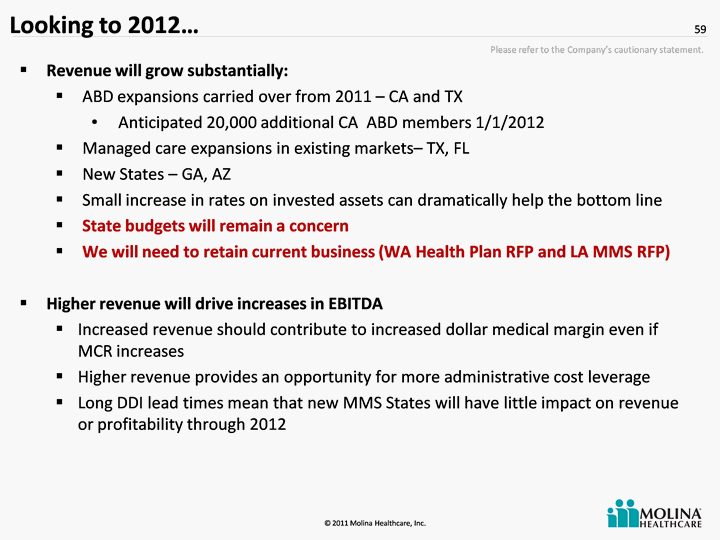
| Looking to 2012... 59 Revenue will grow substantially: ABD expansions carried over from 2011 - CA and TX Anticipated 20,000 additional CA ABD members 1/1/2012 Managed care expansions in existing markets- TX, FL New States - GA, AZ Small increase in rates on invested assets can dramatically help the bottom line State budgets will remain a concern We will need to retain current business (WA Health Plan RFP and LA MMS RFP) Higher revenue will drive increases in EBITDA Increased revenue should contribute to increased dollar medical margin even if MCR increases Higher revenue provides an opportunity for more administrative cost leverage Long DDI lead times mean that new MMS States will have little impact on revenue or profitability through 2012 Please refer to the Company's cautionary statement. |

| What could go wrong with 2012 guidance? 60 2011 projections not achieved Lose existing contracts State rate cuts Don't win RFPs Acute flu season Other identified risk factors Please refer to the Company's cautionary statement. |

| Where are we going in 2012? Total Revenue Medical Care Ratio G&A Ratio EBITDA EBITDA % Please refer to the Company's cautionary statement. 2012G $4.5B 84.8% 8.4% $209M 4.2% $5.0B-$6.0B 85.0%-85.5% 7.8%-8.3% $230M-$280M 4.5% 2011G Note: "G" denotes guidance. Amounts are estimates and subject to change. 61 |

| Q&A 62 |
